• In just over 100 years Scania has built some
Page 40
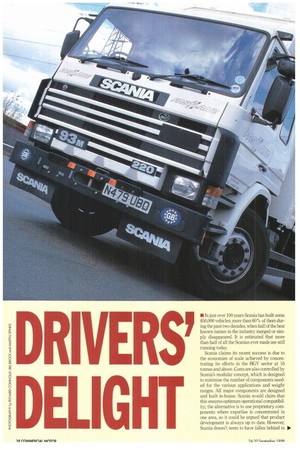
Page 41
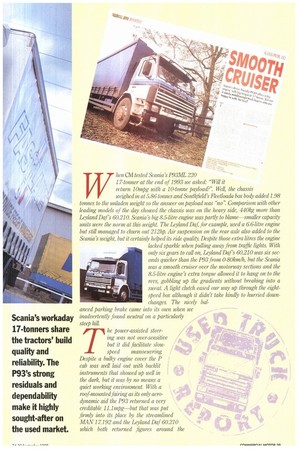
Page 42
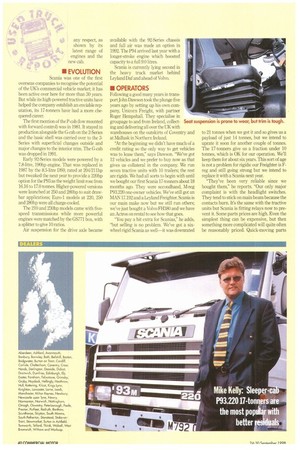
Page 43
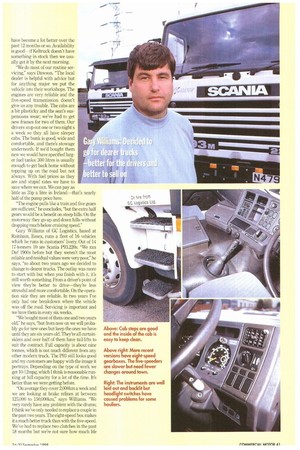
Page 44
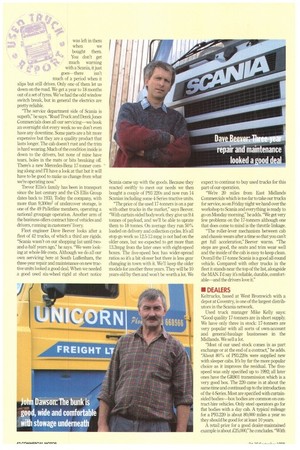
Page 45
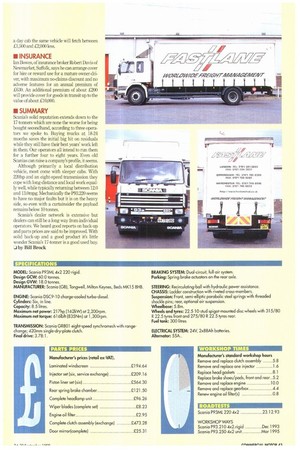
If you've noticed an error in this article please click here to report it so we can fix it.
850,000 vehicles; more than 60% of them during the past two decades, when half of the best known names in the industry merged or simply disappeared. It is estimated that more than half of all the Scanias ever made are still running today.
Scania claims its recent success is due to the economies of scale achieved by concentrating its efforts in the HGV sector at 16 tonnes and above. Costs are also controlled by Scania's modular concept, which is designed to minimise the number of components needed for the various applications and weight ranges. All major components are designed and built in-house. Scania would claim that this ensures optimum operational compatibility; the alternative is to use proprietary components where expertise is concentrated in one area, so it could be argued that product development is always up to date. However, Scania doesn't seem to have fallen behind in
When CM tested Scania's P93ML 220 17-tonner at the end of 1993 we asked: "Will it return lOmpg with a 10-tonne payloacP". Well, the chassis weighed in at 5.86 tonnes and Southfield's Fleetloada box body added 1.98 tonnes to the unladen weight so the answer on payload was "no". Comparison with other leading models of the day showed the chassis was on the heavy side, 440kg more than Leyland Daf's 60.210. Scania's big 8.5-litre engine was partly to blame—smaller capacity units were the norm at this weight. The Leyland Daf, for example, used a 6.6-litre engine but still managed to churn out 212hp. Air suspension on the rear axle also added to the Scania's weight, but it certainly helped its ride quality. Despite those extra litres the engine lacked sparkle when pulling away from traffic lights. With only six gears to call on, Leyland Dais 60.210 was six seconds quicker than the P93 from 0-80km/h, but the Scania was a smooth cruiser over the motorway sections and the 8.5-litre engine's extra torque allowed it to hang on to the revs, gobbling up the gradients without breaking into a sweat. A light dutch eased our way up through the eightspeed box although it didn't take kindly to hurried downchanges. The nicely bal
anced parking brake came into its own when we inadvertently found neutral on a particularly steep hill.
The power-assisted steering was not over-sensitive but it did facilitate slowspeed manoeuvring Despite a bulky engine cover the P cab was well laid out with backlit instruments that showed up well in the dark, but it was by no means a quiet working environment. With a roof-mounted fairing as its only aerodynamic aid the P93 returned a very creditable 11.1mpg—but that was put \ firmly into its place by the streamlined MAN 17192 and the Leyland Daf 60210 which both returned figures around the
oi) 1 any respect, as
, shown by its • . /4„,, latest range of * ‘ .nan, engines and the 0 0 -v--/new cab.
• EVOLUTION
Scania was one of the first overseas companies to recognise the potential of the UK's commercial vehicle market; it has been active over here for more than 30 years. But while its high-powered tractive units have helped the company establish an enviable reputation, its 17-tonners have had a more chequered career.
The first mention of the P-cab (low mounted with forward control) was in 1981. It stayed in production alongside the G-cab on the 2-Series and the basic shell was carried over to the 3Series with superficial changes outside and major changes to the interior trim. The G-cab was dropped in 1991.
Early 92-Series models were powered by a 7.8-litre, 190hp engine. That was replaced in 1987 by the 8.5-litre DS9, rated at 204/211hp but tweaked the next year to provide a 220hp option for the P93 as the weight limit rose from 16.16 to 17.0 tonnes. Higher-powered versions were launched at 250 and 280hp to suit drawbar applications; Ew-o-1 models at 220, 250 and 280hp were all charge-cooled.
The 210 and 230hp models came with fivespeed transmissions while more powerful engines were matched by the GS771 box, with a splitter to give 10 ratios.
Air suspension for the drive axle became
available with the 92-Series chassis and full air was made an option in 1992. The P94 arrived last year with a longer-stroke engine which boosted capacity to a full 9.0 litres.
Scania is currently lying second in the heavy truck market behind Leyland Daf and ahead of Volvo,
• OPERATORS
Following a good many years in transport John Dawson took the plunge five years ago by setting up his own company, Unicorn Freight, with partner Roger Hempshall. They specialise in groupage to and from Ireland, collecting and delivering all over the UK with warehouses on the outskirts of Coventry and at Mallusk in Northern Ireland.
"At the beginning we didn't have much of a credit rating so the only way to get vehicles was to lease them," says Dawson. "We've got 12 vehicles and we prefer to buy now as that gives us collateral in the company. We run seven tractive units with 10 trailers; the rest are rigids. We had all sorts to begin with until we bought our first Scania 17-tonners about 18 months ago. They were secondhand, M-reg P93.220 one-owner vehicles. We've still got an MAN 17.192 and a Leyland Freighter. Scania is our main make now but we still run others; we've just bought a Volvo FH380 and we have an Actros on rental to see how that goes.
"You pay a bit extra for Sc-anias," he adds, "but selling is no problem. We've got a sixwheel rigid Scania as well—it was downrated to 21 tonnes when we got it and so gives us a payload of just 14 tonnes, but we intend to uprate it soon for another couple of tonnes. The 17-tonners give us a fraction under 10 tonnes, which is OK for our operation. We'll keep them for about six years. This sort of age is not a problem for rigids: our Freighter is Freg and still going strong but we intend to replace it with a Scania next year.
"They've been very reliable since we bought them," he reports. "Our only major complaint is with the headlight switches. They tend to stick on main beam because the contacts burn. It's the same with the tractive units but Scania is fitting relays now to prevent it. Some parts prices are high. Even the simplest thing can be expensive, but then something more complicated will quite often be reasonably priced. Quick-moving parts
have become a lot better over the past 12 months or so. Availability is good—if Keltruck doesn't have something in stock then we usu• ally get it by the next morning.
"We do most of our routine servicing," says Dawson. "The local dealer is helpful with advice but for anything major we put the vehicle into their workshops. The engines are very reliable and the five-speed transmission doesn't give us any trouble. The cabs are a bit plasticky and the seat's suspensions wear; we've had to get new frames for two of them, Our drivers stop out one or two night s a week so they all have sleeper cabs. The bunk is good, wide and comfortable, and there's stowage underneath. If we'd bought them new we would have specified larger fuel tanks: 300 litres is usually enough to get back home without topping up on the road but not always. With fuel prices as they are and stupid rates we have to save where we can. We can pay as little as 35p a litre in Ireland—that's nearly half of the pump price here.
"The engine pulls like a train and five gears are sufficient," he concludes, "but the extra half gears would be a benefit on steep hills. On the motorway they go up and down hills without dropping much below cruising speed," Gary Williams of GC Logistics, based at Rainham, Essex, runs a fleet of 16 vehicles which he runs in customers' livery. Out of 14 17-tormers 10 are Scania P93.220s. "We ran Daf 1900s before but they weren't the most reliable and residual values were very poor," he says, "so about two years ago we decided to change to dearer trucks. The outlay was more to start with but when you finish with it, it's still worth something. From a driver's point of view they're better to drive—they're less stressful and more comfortable. On the operation side they are reliable. In two years I've only had one breakdown where the vehicle was off the road. Servicing is important and we have them in every six weeks.
We bought most of them one and two years old," he says, "but from now on we will probably go for new ones but keep the ones we have until they are six years old. They're all curtainsiders and over half of them have tail-lifts to suit the contract. Full capacity is about nine tonnes, which is not much different from any other modern truck. The P93 still looks good and my customers are happy with the image it portrays. Depending on the type of work we get 10-12mpg, which I think is reasonable running at full capacity for a lot of the time. It's better than we were getting before.
"On average they cover 2,000km a week and we are looking at brake relines at between 125,000 to 150,000km," says Williams. "We very rarely have any problem with the drums; 1 think we've only needed to replace a couple in the past two years. The eight-speed box makes it a much better truck than with the five-speed. We've had to replace two clutches in the past 18 months hut we're not sure how much life was left in them when we bought them. You don't get much warning with a Scania, it just goes—there isn't much of a period when it slips but still drives. Only one of them let us down on the road. We get a year to 18 months out of a set of tyres. We've had the odd window switch break, but in general the electrics are pretty reliable.
"The service department side of Scania is superb," he says. "Road Truck and Derek Jones Commercials does all our servicing—we book an overnight slot every week so we don't even have any downtime. Some parts are a bit more expensive but they are a quality product that lasts longer. The cab doesn't rust and the trim is hard wearing Much of the condition inside is down to the drivers, but none of mine have tears, holes in the mats or bits breaking off. There's a new Mercedes-Benz 17-tonner coming along and fll have a look at that but it will have to be good to make us change from what we're operating now"
Trevor Ellis's family has been in transport since the last century and the CS Ellis Group dates back to 1933. Today the company, with more than 9,300m2 of undercover storage, is one of the 49 Palletline members, operating a national groupage operation. Another arm of the business offers contract hire of vehicles and drivers, running in customers' livery.
Fleet engineer Dave Beever looks after a fleet of 42 trucks, of which a third are rigid& "Scania wasn't on our shopping list until twoand-a-half years ago," he says. "We were looking at whole-life costs. Although we do all our own servicing here at South Luffenham, the three-year repair and maintenance on new tractive units looked a good deal. When we needed a good used six-wheel rigid at short notice Scania came up with the goods. Because they reacted swiftly to meet our needs we then bought a couple of P93 220s and now run 14 Scanias including some 4-Series tractive units.
"The price of the used 17-tonners is on a par with other trucks in the market," says Beever. "With curtain-sided bodywork they give us 9.4 tonnes of payload, and we'll be able to uprate them to 18 tonnes. On average they run 50% loaded on delivery and collection cycles. It's all stop-go work so 12.5-13 mpg is not bad on the older ones, but we expected to get more than 13,3mpg from the later ones with eight-speed boxes. The five-speed box has wider-spread ratios so it's a bit slower but there is less gear changing in town with it. We'll keep the older models for another three years. They will be 10 years old by then and won't be worth a lot. We expect to continue to buy used trucks for this part of our operation.
"We're 20 miles from East Midlands Commercials which is too far to take our trucks for service, so on Friday night we hand over the workshop to Scania and everything is ready to go on Monday morning," he adds. "We get very few problems on the 17-tonners although one that does come to mind is the throttle linkage.
"The roller-lever mechanism between cab and chassis wears after a time so that you can't get full acceleration," Beever warns. "The steps are good, the seats and trim wear well and the inside of the cab is easy to keep clean. Overall the 17-tonne Scania is a good all-round vehicle. Compared with other trucks in the fleet it stands near the top of the list, alongside the MAN. I'd say it's reliable, durable, comfortable—and the drivers love it."
• DEALERS
Keltrucks, based at West Bromwich with a depot at Coventry, is one of the largest distributors in the Scania network.
Used truck manager Mike Kelly says: "Good quality 17-tonners are in short supply. We have only three in stock: 17-tonners are very popular with all sorts of own-account and general-haulage businesses in the Midlands. We sell a lot.
"Most of our used stock comes in as part exchange or at the end of a contract," he adds, "About 80% of P93220s were supplied new with sleeper cabs. It's by far the more popular choice as it improves the residual. The fivespeed was only specified up to 1992; all later ones have the GR801 transmission which is a very good box. The 220 came in at about the same time and continued up to the introduction of the 4-Series. Most are specified with curtainsided bodies—box bodies are common on contract-hire vehicles. Only steel operators go for flat bodies with a day cab. A typical mileage for a P93.220 is about 80,000 miles a year so they should be good for at least 10 years.
A retail price for a good dealer-maintained example is about X25,000," he concludes. "With a day cab the same vehicle will fetch between £1,500 and £2,000 less.
• INSURANCE
Ian Bowes, of insurance broker Robert Davis of New-market, Suffolk, says he can arrange cover for hire or reward use for a mature owner-driver, with maximum no-claims discount and no adverse features for an annual premium of £630. An additional premium of about £200 will provide cover for goods in transit up to the value of about £10,000.
III SUMMARY
Scania's solid reputation extends down to the 17-thnners which are none the worse for being bought secondhand, according to three operators we spoke to. Buying trucks at 18-24 months saves the initial big hit on residuals while they still have their hest years' work left in them. Our operators all intend to run them for a further four to eight years. Even old Scanias can raise a company's profile, it seems.
Although primarily a local distribution vehicle, most come with sleeper cabs. With 220hp and an eight-speed transmission they cope with long-distance and local work equally well, while typically returning between 12.0 and 13.0mpg. Mechanically the P93220 seems to have no major faults but it is on the heavy side, so even with a curtainsider the payload remains below 10 tonnes.
Scania's dealer network is extensive but dealers can still be a long way from individual operators. We heard good reports on back-up and parts prices are said to be improved. With solid back-up and a good product it's little wonder Scania's 17-tormer is a good used buy. _I by Bill Brock DEALERS Aberdeen, Ashford, Avonmouth, Banbury, Barnsley, Both, Bel !shill, Boston, Bridgwater, Burton on Trent, Cardiff, Codisle, Chelterthom, Coventry, Cross Hands, Darlington, Deeside, Didcoi, Droitwich, Dumfries, Edinburgh, Ely, Exeter, Fareham, Felixstowe, Grimsby, Groby, Haydock, Hellingly, Heathrow, Hull, Kettering, Ki!cot Kings Lynn, Knighton, Lancaster, Lorne, Leeds, Manchester, Milton Keynes, Newbury, Newcastle upon Tyne, Newry, Normanton, Norwich, Nottingham, Omagh, Oswestry, Peterborough, Poole, Preston, Putfleet, Redruth, Renfrew, Scunthorpe, Slapton, South Mimms, South Petherton, Stanstead, Stoke-anTrent, Stowmarket, Sutton in Ashfield, Tomworth, Telford, Thirsk, Walsall, West Bromwich, Witham and Worksop. SPECIFICATIONS MODEL Scania P93ML 4x2 220 rigid.
Design GCW: 60.0 tonnes.
Design GVVV: 18.0 tonnes.
MANUFACTURER: Scania (GB), Tongwell, Milton Keynes, Beds MKI5 81-18.
ENGINE: Scania DSC9-10 charge-cooled turbo-diesel. Cylinders: Six, in line.
Capacity: 8.5 litres.
Maximum net power: 217hp (162kW) at 2,200rpm. Maximum net torque: 616Ibft (835Nm) at 1,300rpm.
TRANSMISSION: Scania GR801 eight-speed synchromesh with rangechange; 420mm single-dry-plate clutch. Final drive: 3.78:1. BRAKING SYSTEM: Dual-circuit, full-air system. Parking: Spring brake actuators on the rear axle.
STEERING: Recirculating-ball with hydraulic power assistance. CHASSIS: Ladder construction with riveted cross-members.
Suspension: Front, semi-elliptic parabolic steel springs with threaded shackle pins; rear, optional air suspension.
Wheelbase: 5.8m.
Wheels and tyres: 22.5 10-stud spigot-mounted disc wheels with 315/80 R 22.5 tyres front and 275/80 R 22.5 lyres rear. Fuel tank: 300 litres ELECTRICAL SYSTEM: 24V, 2x88Ah batteries. Alternator: 55A.
Manufacturer's prices (retail ex-VAT).
Laminated windscreen £194.64 Injector set (six, service exchange)
£209.16
Piston liner set (six)
£564.30 Rear spring brake chamber £121.50
Complete headlamp unit
£96.26
Wiper blades (complete set)
£8.23 Engine oil filter
£2.95
Complete clutch assembly (exchange)
£473.28 Door mirror(complete) £25.31
WORKSHOP TIMES
Manufacturer's standard workshop hours
Remove and replace clutch assembly 5.8 Remove and replace one injector 1.6 Replace head gaskets 8.1 Replace brake shoes/pads, front and rear 5.2 Remove and replace engine 10.0 Remove and replace gearbox 4.4 Renew engine oil filter(s) 0.8 ROADTESTS Scania P93MI. 220 4x2 23.12.93 WORKSHOP WAYS
Sarnia P93,210 4x2. rigid Dec 1993 Scenic P93.250 4x2 unit Mar 1995




























































































































